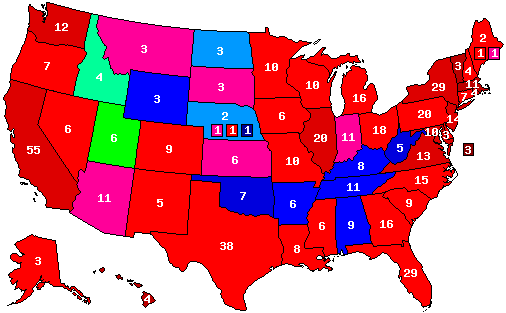Rosa Luxemburg
Banned
Alright. That ends with 271 for Jackson and 267 for Bush.I'd trade the Carolinas for Mississippi and Georgia, since they had larger black populations.
Alright. That ends with 271 for Jackson and 267 for Bush.I'd trade the Carolinas for Mississippi and Georgia, since they had larger black populations.
Alright. That ends with 271 for Jackson and 267 for Bush.

Steve Bullock/Kamala Harris 47% Popular Vote ~ 473 Electoral Votes
Donald Trump/Mike Pence 33% Popular Vote ~ 55 Electoral Votes
Mitt Romney/Evan McMullin 18% Popular Vote ~ 10 Electoral Votes
The Elephant And The Bull Moose: 1952

With the recent buzz about Kasich possibly attempting to primary Trump in 2020, I thought I'd make a map for what Kasich's winning map would be if he were in fact to successfully primary Trump (which is of course very, very unlikely)

I may work on a county map for this as well.
Yes, which would most likely lead to a 1912 type scenario.Trump would most likely run third party in this scenario correct?
Excellent. Split that mf vote like a boss, baby!Yes, which would most likely lead to a 1912 type scenario.
Ran a 1872 PI game as a simulator and I got this result
View attachment 339722
I unfortunately dont know a whole lot about the reconstruction era, and i have no clue who Greeley is, or why the "Liberal Republicans" won most of the south, but i was wondering if this was
1) Plausible
2) What effect this would have on electoral politics in the future
Ah, thank youGreeley ran under the Liberal Republican Party, which was a breakaway from the Republicans that was more pro-states' rights, more like what a moderate GOP would be back in the day.
shameAs the above poster said, the Democrats endorsed Greeley that year. Not too sure how it would have continued going forward. The parties probably would have combined as they did under Bryan with the Democrats and the Populists, but, seeing as most just protested against a corrupt GOP, there might have been an even split within the LRP. The party probably wouldn't have lasted long.
Maybe we would have seen a different party system? The Bourbon Democrats* end up as Republicans instead, while the Half-Breeds* join the Liberal Republicans (it would probably end up being called "Liberal" or something like that)?As the above poster said, the Democrats endorsed Greeley that year. Not too sure how it would have continued going forward. The parties probably would have combined as they did under Bryan with the Democrats and the Populists, but, seeing as most just protested against a corrupt GOP, there might have been an even split within the LRP. The party probably wouldn't have lasted long.